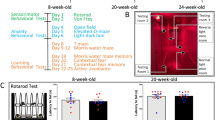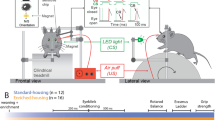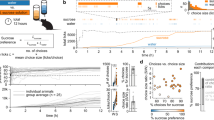Abstract
Animal behavioral models are crucial for neurobiological research, allowing for the thorough investigation of brain pathogenesis to be performed. In both animals and humans, anxiety has long been linked to vestibular disorders. However, although there are many tests of anxiety and vestibular deficits, there are few protocols that address the interplay between these two domains. The Suok test and its light–dark modification presented here appear to be suitable for testing this pathogenetic link in laboratory rodents. This protocol adds a new dimension to previously used tests by assessing animal anxiety and balancing simultaneously, resulting in efficient, high-throughput screens for testing psychotropic drugs, phenotyping genetically modified animals, and modeling clusters of human disorders related to stress/anxiety and balancing.
This is a preview of subscription content, access via your institution
Access options
Subscribe to this journal
Receive 12 print issues and online access
$259.00 per year
only $21.58 per issue
Buy this article
- Purchase on Springer Link
- Instant access to full article PDF
Prices may be subject to local taxes which are calculated during checkout



Similar content being viewed by others
References
Crawley, J.N. What's Wrong With My Mouse? Behavioral Phenotyping of Transgenic and Knockout Mice (Wiley-Liss, New York, 2000).
Tecott, L.H. & Nestler, E.J. Neurobehavioral assessment in the information age. Nat. Neurosci. 7, 462–466 (2004).
Crabbe, J.C. & Morris, R.G. Festina lente: late-night thoughts on high-throughput screening of mouse behavior. Nat. Neurosci. 7, 1175–1179 (2004).
Wotjak, C.T. Of mice and men. Potentials and caveats of behavioral experiments with mice. B.I.F. Futura 19, 158–169 (2004).
Kalueff, A.V., Wheaton, M. & Murphy, D.L. What's wrong with my mouse model? Advances and strategies in animal modeling of anxiety and depression. Behav. Brain Res. 179, 1–18 (2007).
Kalueff, A., Ishikawa, K. & Griffith, A. Anxiety and vestibular disorders: linking behavioral phenotypes in men and mice. Behav. Brain Res. 186, 1–11 (2007).
Balaban, C.D. & Thayer, J.F. Neurological bases for balance-anxiety links. J. Anxiety Disord. 15, 53–79 (2001).
Balaban, C.D. Neural substrates linking balance control and anxiety. Physiol. Behav. 77, 469–475 (2002).
Furman, J.M., Balaban, C.D. & Jacob, R.G. Interface between vestibular dysfunction and anxiety: more than just psychogenicity. Otol. Neurotol. 22, 426–427 (2001).
Balaban, C.D. & Jacob, R.G. Background and history of the interface between anxiety and vertigo. J. Anxiety Disord. 15, 27–51 (2001).
Le Marec, N. & Lalonde, R. Sensorimotor learning and retention during equilibrium tests in Purkinje cell degeneration mutant mice. Brain Res. 768, 310–316 (1997).
Lepicard, E.M. et al. Balance control and posture differences in the anxious BALB/cByJ mice compared to the non anxious C57BL/6J mice. Behav. Brain Res. 117, 185–195 (2000).
Lepicard, E.M., Joubert, C., Hagneau, I., Perez-Diaz, F. & Chapouthier, G. Differences in anxiety-related behavior and response to diazepam in BALB/cByJ and C57BL/6J strains of mice. Pharmacol. Biochem. Behav. 67, 739–748 (2000).
Lepicard, E.M. et al. Posture and balance responses to a sensory challenge are related to anxiety in mice. Psychiatry Res. 118, 273–284 (2003).
Lepicard, E.M. et al. Spatio-temporal analysis of locomotion in BALB/cByJ and C57BL/6J mice in different environmental conditions. Behav. Brain Res. 167, 365–372 (2006).
Venault, P. et al. Balance control and posture in anxious mice improved by SSRI treatment. Neuroreport 12, 3091–3094 (2001).
Kalueff, A.V., Minasyan, A. & Tuohimaa, P. Behavioural characterization in rats using the elevated alley Suok test. Behav. Brain Res. 165, 52–57 (2005).
Kalueff, A.V. & Tuohimaa, P. The Suok (“ropewalking”) murine test of anxiety. Brain Res. Brain Res. Protoc. 14, 87–99 (2005).
Kalueff, A., Minasyan, A., Keisala, T. & Tuohimaa, P. A new behavioral paradigm for anxiety research in rodents-the Suok “ropewalking” test. In Trends in Brain Research (ed. Chen, F.J.) 89–116 (Nova Science, New York, 2006).
Lalonde, R., Le Pêcheur, M., Strazielle, C. & London, J. Exploratory activity and motor coordination in wild-type SOD1/SOD1 transgenic mice. Brain Res. Bull. 66, 155–162 (2005).
Stanley, J.L. et al. The mouse beam walking assay offers improved sensitivity over the mouse rotarod in determining motor coordination deficits induced by benzodiazepines. J. Psychopharmacol. 19, 221–227 (2005).
Paffenholz, R. et al. Vestibular defects in head-tilt mice result from mutations in Nox3, encoding an NADPH oxidase. Genes Dev. 18, 486–491 (2004).
Lalonde, R., Botez, M.I., Joyal, C.C. & Caumartin, M. Motor abnormalities in lurcher mutant mice. Physiol. Behav. 51, 523–525 (1992).
Montgomery, K.C. The relation between fear induced by novel stimulation and exploratory behavior. J. Comp. Physiol. Psychol. 48, 254–260 (1955).
Montgomery, K.C. & Monkman, J.A. The relation between fear and exploratory behavior. J. Comp. Physiol. Psychol. 48, 132–136 (1955).
Crawley, J.N. Behavioral phenotyping of transgenic and knockout mice: experimental design and evaluation of general health, sensory functions, motor abilities, and specific behavioral tests. Brain Res. 835, 18–26 (1999).
Walf, A.A. & Frye, C.A. The use of the elevated plus maze as an assay of anxiety-related behavior in rodents. Nat. Protoc. 2, 322–328 (2007).
Lalonde, R., Dumont, M., Paly, E., London, J. & Strazielle, C. Characterization of hemizygous SOD1/wild-type transgenic mice with the SHIRPA primary screen and tests of sensorimotor function and anxiety. Brain Res. Bull. 64, 251–258 (2004).
Crabbe, J.C. et al. Genotypic differences in ethanol sensitivity in two tests of motor incoordination. J. Appl. Physiol. 95, 1338–1351 (2003).
Kalueff, A.V., Keisala, T., Minasyan, A. & Tuohimaa, P. Influence of paternal genotypes on F1 behaviors: lessons from several mouse strains. Behav. Brain Res. (2006).
Wolfer, D.P. et al. Laboratory animal welfare: cage enrichment and mouse behaviour. Nature 432, 821–822 (2004).
Wurbel, H. Publications should include an animal-welfare section. Nature 446, 257 (2007).
Kalueff, A.V. & Murphy, D.L. The importance of cognitive phenotypes for experimental modeling of animal anxiety and depression. Neural Plast. 2007, 1–7 (2007).
Kalueff, A.V., Keisala, T., Minasyan, A. & Tuohimaa, P. Pharmacological modulation of anxiety-related behaviors in the murine Suok test. Brain Res. Bull. 74, 45–50 (2007).
Deacon, R.M. Housing, husbandry and handling of rodents for behavioral experiments. Nat. Protoc. 1, 936–946 (2006).
Noldus, L.P., Spink, A.J. & Tegelenbosch, R.A. EthoVision: a versatile video tracking system for automation of behavioral experiments. Behav. Res. Methods Instrum. Comput. 33, 398–414 (2001).
Spink, A.J., Tegelenbosch, R.A., Buma, M.O. & Noldus, L.P. The EthoVision video tracking system—a tool for behavioral phenotyping of transgenic mice. Physiol. Behav. 73, 731–744 (2001).
Pellow, S., Chopin, P., File, S.E. & Briley, M. Validation of open:closed arm entries in an elevated plus-maze as a measure of anxiety in the rat. J. Neurosci. Methods 14, 149–167 (1985).
Willis-Owen, S.A. & Flint, J. The genetic basis of emotional behaviour in mice. Eur. J. Hum. Genet. 14, 721–728 (2006).
Willis-Owen, S.A. & Flint, J. Identifying the genetic determinants of emotionality in humans; insights from rodents. Neurosci. Biobehav. Rev. 31, 115–124 (2007).
Dodart, J.C. et al. Behavioral disturbances in transgenic mice overexpressing the V717F beta-amyloid precursor protein. Behav. Neurosci. 113, 982–990 (1999).
Allbutt, H.N. & Henderson, J.M. Use of the narrow beam test in the rat, 6-hydroxydopamine model of Parkinson's disease. J. Neurosci. Methods 159, 195–202 (2007).
Kalueff, A.V., Jensen, C.L. & Murphy, D.L. Locomotory patterns, spatiotemporal organization of exploration and spatial memory in serotonin transporter knockout mice. Brain Res. 1169, 87–97 (2007).
Wurbel, H. Ideal homes? Housing effects on rodent brain and behaviour. Trends Neurosci. 24, 207–211 (2001).
McIlwain, K.L., Merriweather, M.Y., Yuva-Paylor, L.A. & Paylor, R. The use of behavioral test batteries: effects of training history. Physiol. Behav. 73, 705–717 (2001).
Lalonde, R., Hayzoun, K., Selimi, F., Mariani, J. & Strazielle, C. Motor coordination in mice with hotfoot, Lurcher, and double mutations of the Grid2 gene encoding the delta-2 excitatory amino acid receptor. Physiol. Behav. 80, 333–339 (2003).
Lalonde, R. & Strazielle, C. Motor coordination, exploration, and spatial learning in a natural mouse mutation (nervous) with Purkinje cell degeneration. Behav. Genet. 33, 59–66 (2003).
Lalonde, R., Kim, H.D. & Fukuchi, K. Exploratory activity, anxiety, and motor coordination in bigenic APPswe + PS1/DeltaE9 mice. Neurosci. Lett. 369, 156–161 (2004).
Lalonde, R., Dumont, M., Staufenbiel, M. & Strazielle, C. Neurobehavioral characterization of APP23 transgenic mice with the SHIRPA primary screen. Behav. Brain. Res. 157, 91–98 (2005).
Lalonde, R., Marchetti, N. & Strazielle, C. Primary neurologic screening and motor coordination of Dstdt-J mutant mice (dystonia musculorum) with spinocerebellar atrophy. Physiol. Behav. 86, 46–51 (2005).
Kalueff, A. & Tuohimaa, P. Pharmacological validation of the mouse elevated horizontal rod (the Suok test) as a novel experimental model of anxiety: sensitivity to diazepam and pentylenetetrazole. Eur. Neuropsychopharmacol. 15, S40–S41 (2005).
Golani, I., Benjamini, Y. & Eilam, D. Stopping behavior: constraints on exploration in rats (Rattus norvegicus). Behav. Brain Res. 53, 21–33 (1993).
Kalueff, A., Aldridge, J.W., Laporte, J.L., Murphy, D. & Tuohimaa, P. Analyzing grooming microstructure in neurobehavioral experiments. Nat. Protoc. 11, 1–8 (2007).
Kalueff, A.V., Ren-Patterson, R.F. & Murphy, D.L. The developing use of heterozygous mutant mouse models in brain monoamine transporter research. Trends Pharmacol. Sci. 28, 122–127 (2007).
Cruz, A.P., Frei, F. & Graeff, F.G. Ethopharmacological analysis of rat behavior on the elevated plus-maze. Pharmacol. Biochem. Behav. 49, 171–176 (1994).
Tubaltseva, V. & Makarchuk, N.E. Anxiolytic-like effects of quercetine in rats tested in the Suok test of anxiety. Stress Behav. Proc. 5, 134–135 (2007).
Staab, J.P., Ruckenstein, M.J., Solomon, D. & Shepard, N.T. Serotonin reuptake inhibitors for dizziness with psychiatric symptoms. Arch. Otolaryngol. Head Neck Surg. 128, 554–560 (2002).
Black, K., Shea, C., Dursun, S. & Kutcher, S. Selective serotonin reuptake inhibitor discontinuation syndrome: proposed diagnostic criteria. J. Psychiatry Neurosci. 25, 255–261 (2000).
Ramos, R.T. Antidepressants and dizziness. J. Psychopharmacol. 20, 708–713 (2006).
Kamens, H.M. & Crabbe, J.C. The parallel rod floor test: a measure of ataxia in mice. Nat. Protoc. 2, 277–281 (2007).
Geyer, M.A. et al. The effects of lysergic acid diethylamide and mescaline-derived hallucinogens on sensory-integrative function: tactile startle. J. Pharmacol. Exp. Ther. 207, 837–847 (1978).
Geyer, M.A. et al. A characteristic effect of hallucinogens on investigatory responding in rats. Psychopharmacology (Berl.) 65, 35–40 (1979).
Geyer, M.A. & Light, R.K. LSD-induced alterations of investigatory responding in rats. Psychopharmacology (Berl.) 65, 41–47 (1979).
Kafkafi, N. Extending SEE for large-scale phenotyping of mouse open-field behavior. Behav. Res. Methods Instrum. Comput. 35, 294–301 (2003).
Kafkafi, N. et al. SEE locomotor behavior test discriminates C57BL/6J and DBA/2J mouse inbred strains across laboratories and protocol conditions. Behav. Neurosci. 117, 464–477 (2003).
Kafkafi, N. & Golani, I. A traveling wave of lateral movement coordinates both turning and forward walking in the ferret. Biol. Cybern. 78, 441–453 (1998).
Kafkafi, N. et al. Darting behavior: a quantitative movement pattern designed for discrimination and replicability in mouse locomotor behavior. Behav. Brain Res. 142, 193–205 (2003).
Kafkafi, N. & Elmer, G.I. Texture of locomotor path: a replicable characterization of a complex behavioral phenotype. Genes Brain Behav. 4, 431–443 (2005).
Kafkafi, N., Benjamini, Y., Sakov, A., Elmer, G.I. & Golani, I. Genotype-environment interactions in mouse behavior: a way out of the problem. Proc. Natl. Acad. Sci. USA 102, 4619–4624 (2005).
Kafkafi, N. & Elmer, G.I. Activity density in the open field: a measure for differentiating the effect of psychostimulants. Pharmacol. Biochem. Behav. 80, 239–249 (2005).
Flagel, S.B. & Robinson, T.E. Quantifying the psychomotor activating effects of cocaine in the rat. Behav. Pharmacol. 18, 297–302 (2007).
Acknowledgements
The preparation of this protocol was supported in part by the Medical Research Foundation of Tampere University Hospital (Finland), the Intramural Research Program of the National Institute of Mental Health (NIH/NIMH, USA), and NARSAD (USA) YI Award (to A.V.K.). The authors thank Marianne Kuuslahti and Newlin Morgan for their excellent technical help.
Author information
Authors and Affiliations
Corresponding author
Supplementary information
Supplementary Video 1
Rich spectrum of exploratory and motor behaviors that can be registered in the rodent Suok test. (MP4 8191 kb)
Supplementary Video 2
Effects of psychotropic drug lysergic acid diethylamide (LSD) on mouse Suok test behavior. (MP4 8747 kb)
Rights and permissions
About this article
Cite this article
Kalueff, A., Keisala, T., Minasyan, A. et al. The regular and light–dark Suok tests of anxiety and sensorimotor integration: utility for behavioral characterization in laboratory rodents. Nat Protoc 3, 129–136 (2008). https://doi.org/10.1038/nprot.2007.516
Published:
Issue Date:
DOI: https://doi.org/10.1038/nprot.2007.516
This article is cited by
-
Age- and Sex-Related Features of the Behavior of Prenatally Stressed Rats Using a Dark/Light Modification of the Behavioral “Suok” Test
Neuroscience and Behavioral Physiology (2023)
-
Persistent autism-relevant behavioral phenotype and social neuropeptide alterations in female mice offspring induced by maternal transfer of PBDE congeners in the commercial mixture DE-71
Archives of Toxicology (2022)
-
Potentiation of the apoptotic signaling pathway in both the striatum and hippocampus and neurobehavioral impairment in rats exposed chronically to a low−dose of cadmium
Environmental Science and Pollution Research (2021)
-
Effects of Quercetin on Neurodegenerative and Compensatory Processes in the Nigrostriatal System in a Model of the Preclinical Stage of Parkinson’s Disease in Rats
Neuroscience and Behavioral Physiology (2017)
-
Resolving the neural circuits of anxiety
Nature Neuroscience (2015)
Comments
By submitting a comment you agree to abide by our Terms and Community Guidelines. If you find something abusive or that does not comply with our terms or guidelines please flag it as inappropriate.



